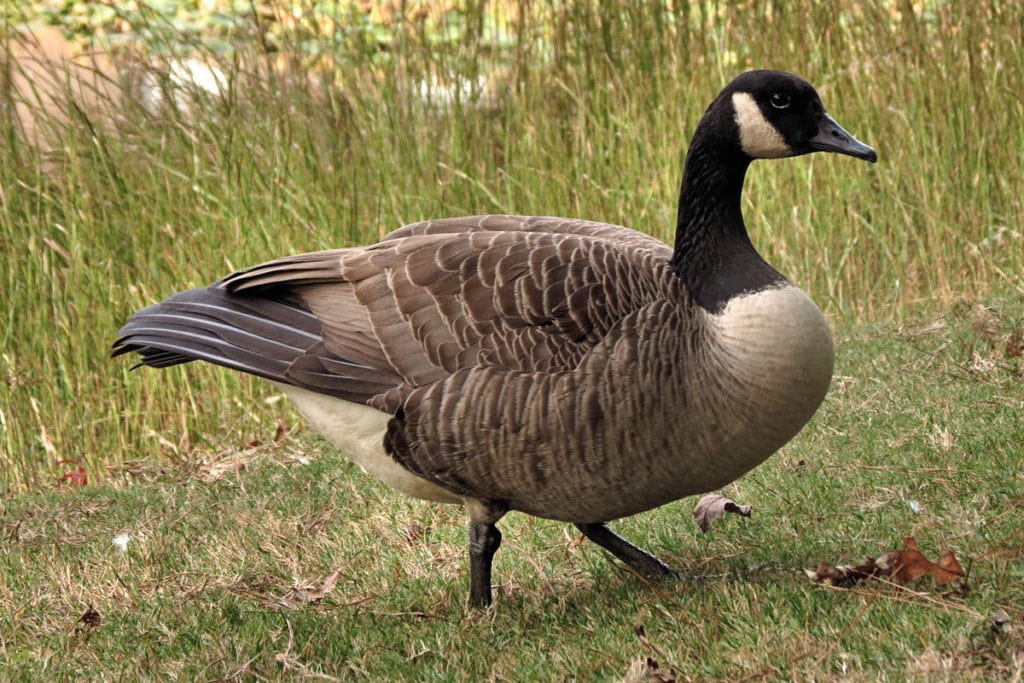Goose Removal

Canada Goose (Branta canadensis)
Goose Removal is important for your commercial property, airport, or residence. Let’s face it, we all know that wherever Canada geese gather, their droppings will soon follow. But instead of resorting to extreme measures like culling entire flocks, we should focus on finding humane and effective solutions. This is especially important around airports, where safety is a top priority for both humans and wildlife. By making the airport and its surrounding areas less attractive to geese, we can create a safer environment for all. If you are interested in goose removal, contact Wildlife Damage Solutions today.
Why Canadian Geese are Protected
Canadian geese are protected for their vital role in maintaining ecosystem balance, representing a conservation success story, and symbolizing Canadian culture. These birds benefit from international treaties and offer ecotourism opportunities. To delve deeper into the significance of Canadian geese and their conservation, read our blog on “Why are Canadian Geese Protected? A look at wildlife laws”
Why Canadian Geese Need to be Removed
Canadian geese, known for their graceful appearance and iconic honking, can also pose certain risks and be considered dangerous in specific situations. Here are some reasons why Canadian geese can be perceived as a threat:
1. Aggressive Behavior: During their nesting season, which typically occurs in the spring, Canadian geese can become territorial and highly protective of their nests and goslings. If they feel their young are threatened, they may exhibit aggressive behavior, including hissing, charging, and biting, potentially causing harm to humans or pets.
2. Aircraft Collisions: Canadian geese are particularly notorious for posing risks to aviation. Collisions between aircraft and these large birds can lead to damage to the aircraft and, in some cases, pose a danger to passengers and crew. Airports and aviation authorities take measures to manage and mitigate these risks. Read more here about our wildlife management for safe aircraft operations.
3. Environmental Impact: In certain regions, Canadian geese can have negative environmental impacts. Their grazing habits can damage crops, lawns, and natural vegetation, leading to concerns about overgrazing and ecosystem disruption.
4. Disease Transmission: While relatively rare, there have been instances of Canadian geese carrying diseases such as avian influenza. Close contact with these birds, their droppings, or their nesting areas can potentially pose a health risk.
Large numbers of geese leave behind large quantities of feces. A single goose can defecate every 20 minutes (Bowen and Valiela 2004) up to 1.5 pounds of feces each day (French and Parkhurst 2009). This problem is magnified when we realize that approximately 67% of geese around Kansas City are non-migratory or resident geese (Dolbeer 2006). In other words, land, lakes, ponds, and streams frequently do not get a sustained rest from geese’ presence. If large numbers of geese congregate, the health risks related to the feces left on the ground and in the water are significantly high.
According to Medical News Today, the most common pathogens which can cause disease transmitted from geese to humans are:
E coli: This occurs when bird droppings land in water or food supply and are then consumed by humans. This can typically be avoided by washing food thoroughly before eating. Symptoms include nausea, fever, and cramps.
St. Louis encephalitis: This disease is spread by mosquitoes after they feed on a bird that carries the pathogen that spreads St. Louis encephalitis. This inflammation of the nervous system is dangerous to all age groups but can be particularly dangerous and even fatal in adults over 60 years old. Symptoms include drowsiness, headache and fever.
Histoplasmosis: This respiratory disease occurs as a result of a fungus growing in pigeon droppings and can be fatal.
Candidiasis: This disease is also a respiratory condition caused by a fungus or yeast found in droppings. The areas affected include the skin, mouth, the respiratory system, intestines, and the urogenital tract, particularly in women.
Salmonellosis: This disease is commonly called “food poisoning” and spreads via infected droppings turning into dust and contaminating food and food preparation surfaces prior to consumption.
Chlamydiosis: caused by a bacterial organism, Chlamydophila psittaci (formerly known as Chlamydiapsittaci), and is usually spread by inhaling the organism from dried feces. The bacteria is often transmitted from “carrier” birds. Carriers show no signs of illness, but actively excrete the chlamydia organism in their droppings.
Toxoplasmosis: considered to be a leading cause of death attributed to foodborne illness in the United States. More than 40 million men, women, and children in the U.S. carry the Toxoplasma parasite, but very few have symptoms because the immune system usually keeps the parasite from causing illness.
Giardia: The cysts of giardia have been found in the feces of Canada geese (Graczyk et al. 1998; Kassa et al. 2004, Centers for Disease Control Giardia Factsheet). Giardia is a protozoan parasite that causes gastrointestinal infection in humans (Centers for Disease Control Giardia Factsheet).
Listeria: Converse et al. (1999) found Listeria spp. including Listeria monocytogenes, in geese droppings. Listeriosis is a serious medical threat as infection can cause abortions in pregnant women and result in septicemia and meningitis (The Center for Food Safety and Applied Nutrition 2009).
It’s important to note that while Canadian geese can display aggressive behavior, especially during nesting, and pose some risks, they are generally not a major threat to humans. Most interactions with these birds are peaceful, and they play a valuable role in the ecosystem. As such, understanding and respecting their behavior and habitats is essential to coexisting with these majestic creatures safely.
If Canadian geese are being a nuisance to your home or business, contact Wildlife Damage Solutions today for expert Goose removal.

